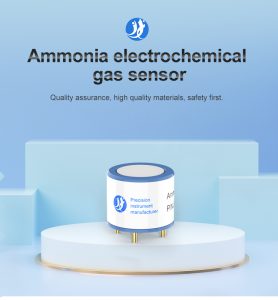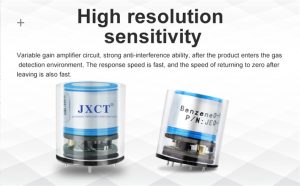The risk of gas leaks and their potential consequences make the implementation of gas detectors essential for ensuring the safety and efficiency of these facilities. Gas detectors play a crucial role in monitoring the plant environment, detecting gas leaks, and providing early warnings to prevent accidents. In this article, we will explore the importance of gas detectors in chemical plants, their working principles, types, installation considerations, and maintenance procedures.

I. Importance of Gas Detectors in Chemical Plants:
Chemical plants handle volatile and toxic substances that can pose serious risks to workers' health and safety.
Gas detectors provide continuous monitoring and early detection of gas leaks, allowing for prompt response and evacuation if necessary.
By alerting personnel of potential hazards, gas detectors help prevent accidents, explosions, and chemical exposures.
Compliance with Regulations:
Regulatory agencies impose stringent safety regulations on chemical plants to protect both workers and the surrounding environment.
Gas detection systems are often a mandatory requirement to ensure compliance with these regulations.
By implementing gas detectors, chemical plants demonstrate their commitment to safety and fulfill legal obligations.
Operational Efficiency:
Gas detectors not only enhance safety but also contribute to operational efficiency.
Early detection of gas leaks minimizes downtime and allows for immediate corrective actions, reducing production losses.
By optimizing response times, gas detectors help prevent equipment damage and subsequent repair or replacement costs.
Catalytic Sensors:
Catalytic sensors are commonly used to detect combustible gases.
They consist of a catalytic element that reacts with flammable gases, causing a rise in temperature.
The change in temperature is detected and converted into an electrical signal, indicating the presence of combustible gases.
Electrochemical Sensors:
Electrochemical sensors are effective in detecting toxic gases such as carbon monoxide, hydrogen sulfide, and ammonia.

When a target gas interacts with the electrode, a chemical reaction occurs, generating an electrical current that is proportional to the gas concentration.
Infrared Sensors:
Infrared sensors are capable of detecting a wide range of gases.
They emit infrared light at specific wavelengths and measure the amount of light absorbed by the target gas.
The decrease in transmitted light intensity indicates the presence and concentration of the gas.
Photoionization Detectors (PID):
PID sensors utilize ultraviolet (UV) light to ionize gas molecules.
The ionization current generated is proportional to the gas concentration and can be measured to determine its level.
III. Types of Gas Detectors:
Fixed gas detectors are permanently installed in strategic locations within the chemical plant.
They continuously monitor gas levels and provide real-time data to a central control system.
Fixed detectors are ideal for areas with a high risk of gas leaks, such as storage tanks, pipelines, and process areas.
Portable Gas Detectors:
Portable gas detectors are handheld devices used for personal safety during routine inspections, maintenance, or emergencies.
These detectors are lightweight, compact, and easily carried by personnel.
Portable gas detectors provide flexibility in monitoring gas levels in various areas of the plant.
IV. Installation Considerations:
Conduct a thorough hazard analysis to identify areas prone to gas leaks.
Install gas detectors in these areas, considering factors such as proximity to potential leak sources, airflow patterns, and gas dispersion characteristics.
Sensor Placement:
Place gas detectors at appropriate heights and positions to ensure effective gas detection.
Consider the specific gravity of gases involved, as some gases may accumulate at different levels.
Calibration:
Gas detectors should be calibrated regularly to maintain accurate readings.
Calibration involves exposing the sensors to known gas concentrations and adjusting them accordingly.
Alarm Systems:
Configure alarm systems to suit the specific needs of the chemical plant.
Set appropriate alarm thresholds for each gas being monitored.
Ensure that alarms are loud, easily distinguishable, and effectively communicated to all personnel in the facility.
V. Maintenance Procedures:
Conduct routine inspections to check the condition of gas detectors, including sensor functionality, power supply, wiring, and alarm systems.
Sensor Replacement:
Gas detector sensors have a limited lifespan and may require replacement periodically.
Follow the manufacturer's guidelines for sensor replacement to ensure continued accuracy and reliability.
Battery Replacement:
Check and replace batteries in portable gas detectors to ensure uninterrupted operation.
Maintain a battery replacement schedule to prevent downtime during critical operations.
Functional Testing:
Perform functional tests on gas detectors to verify their proper operation.
Test the alarms, sensors, and communication systems regularly to ensure that they are functioning as intended.
Conclusion:
Gas detectors play a vital role in ensuring the safety and efficiency of chemical plants. By continuously monitoring the plant environment for gas leaks, these devices help prevent accidents, protect workers, and comply with regulatory requirements. Understanding the working principles of different types of gas detectors and considering factors such as installation, calibration, and maintenance procedures are essential for maximizing their effectiveness. By prioritizing the implementation and proper maintenance of gas detectors, chemical plants can create a safer working environment while optimizing operational productivity.
 : +86 155 8830 2704
: +86 155 8830 2704 : jxdziot@gmail.com
: jxdziot@gmail.com
